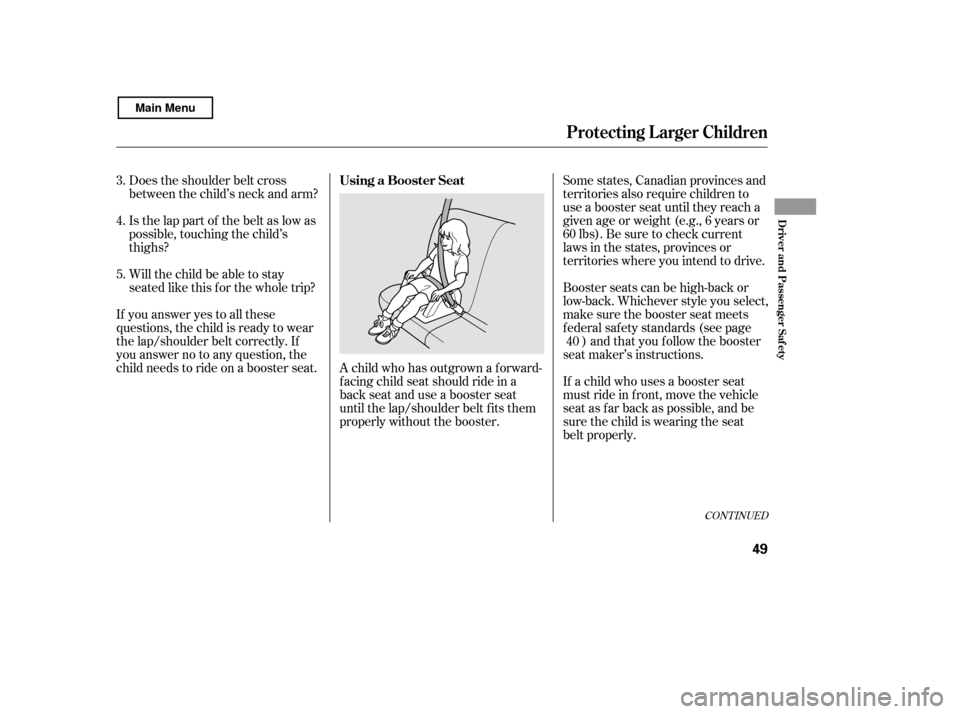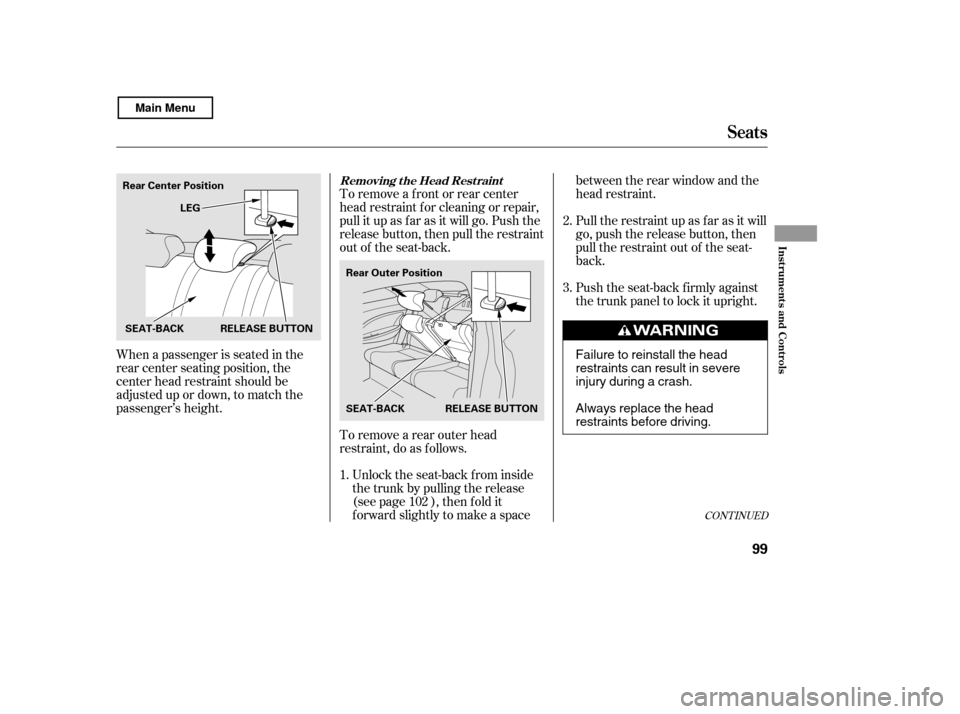Page 53 of 400

Does the shoulder belt cross
between the child’s neck and arm?
Is the lap part of the belt as low as
possible, touching the child’s
thighs?
Will the child be able to stay
seated like this f or the whole trip?
If you answer yes to all these
questions, the child is ready to wear
the lap/shoulder belt correctly. If
you answer no to any question, the
child needs to ride on a booster seat. A child who has outgrown a f orward- f acing child seat should ride in a
back seat and use a booster seat
until the lap/shoulder belt f its them
properly without the booster.Some states, Canadian provinces and
territories also require children to
use a booster seat until they reach a
given age or weight (e.g., 6 years or
60lbs).Besuretocheckcurrent
laws in the states, provinces or
territories where you intend to drive.
Booster seats can be high-back or
low-back. Whichever style you select,
make sure the booster seat meets
f ederal saf ety standards (see page
) and that you f ollow the booster
seat maker’s instructions.
If a child who uses a booster seat
must ride in f ront, move the vehicle
seat as far back as possible, and be
sure the child is wearing the seat
belt properly.
3. 4. 5.
40
CONT INUED
Using a Booster Seat
Protecting L arger Children
Driver and Passenger Saf ety
49
Main Menu
Page 59 of 400

This section gives inf ormation about
the controls and displays that
contribute to the daily operation of
your vehicle. All the essential
controls are within easy reach............................
Control Locations . 56
............................
Instrument Panel . 57
..........
Instrument Panel Indicators . 59
.............................................
Gauges . 67
..............
Display Change Button . 68
.....................................
Odometer . 68
...................................
Trip Meter . 68
Outside Temperature
...................................
Indicator . 69
..................................
Fuel Gauge . 70
...................
Temperature Gauge . 70
..........
Check Fuel Cap Message . 70
...............
Maintenance Minder . 71
Controls Near the Steering
...........................................
Wheel . 72
.
Windshield Wipers and Washers . 73
.........
Turn Signals and Headlights . 74
........................................
Fog Lights . 75
........
Instrument Panel Brightness . 76
.................
Hazard Warning Button . 77
.................
Rear Window Def ogger . 77
........
Steering Wheel Adjustments . 78
...............................
Keys and Locks . 79
........................
Immobilizer System . 80
................................
Ignition Switch . 81 ......................................
Door Locks . 82
......................
Power Door Locks . 83
.
Auto Door Locking/Unlocking . 84
.......................
Remote Transmitter . 89
................................................
Trunk . 93
........
Emergency Trunk Opener . 94
.................................................
Seats . 95
..................................
Seat Heaters . 103
............................
Power Windows . 104
.......................................
Moonroof . 106
...........................................
Mirrors . 108
...............................
Parking Brake . 109
.........
Interior Convenience Items . 110
.....................
Beverage Holders . 111
.............
Console Compartment . 111
..................................
Glove Box . 111
..................................
Coat Hook . 112
........
Accessory Power Sockets . 112
............................
Vanity Mirror . 113
...................................
Sun Visor . 114
...............................
Interior Lights . 114
..............................
Ceiling Light . 114
...................................
Spotlights . 115
..........................
Courtesy Light . 116
Instruments and Controls
Inst rument s and Cont rols
55
TM
Main Menu
Page 99 of 400
�µ
To change the seat-back angle, pull
up on the lever on the outside of the
seat bottom.
Make all seat adjustments bef ore
you start driving.
To adjust the seat f orward or
backward, pull up on the bar under
the seat cushion’s f ront edge. Move
the seat to the desired position, and
releasethebar.Trytomovetheseat
to make sure it is locked in position.Once a seat is adjusted correctly,
rock it back and f orth to make sure it
is locked in position.
See pages f or important saf ety
inf ormation and warnings about how toproperly position the seats and seat-
backs. 11 13
FrontSeatAdjustments
Seats
Inst rument s and Cont rols
95
Main Menu
Page 100 of 400
The height of your driver’s seat is
adjustable. To raise the seat bottom,
repeatedly pull up the lever on the
outside of the seat cushion. To lower
the seat, push the lever down
repeatedly.
Make all seat adjustments bef ore
you start driving.To get into the rear seat on the
driver’s side, open the door and pull
up on the seat-back adjustment lever.
The seat-back will tilt f orward to
allow easier entry to the rear seat.
To use the console lid as an armrest,
slide it to one of its three positions.On all models except U.S. DX
Driver’s Seat Height A djustment A rmrest Rear Seat A ccess
Driver’s Side
Seats
96
SEAT-BACK ADJUSTMENT LEVER
Main Menu
Page 101 of 400
To get into the rear seat on the
passenger’s side, push downward on
the release lever at the base of the
seat-back or pull up on the seat-back
adjustment lever. The seat-back will
tilt f orward to allow easier entry to
the rear seat.When you push down the release
lever or pull up the adjustment lever,
the seat will also move forward.
Af ter a passenger gets into the back
seat, push the seat-back to the
upright position, and push the seat
backwards until it latches. Make
sure the seat is f ully latched bef ore
sitting in it.
Except U.S. DX
Passenger’s Side
Seats
Inst rument s and Cont rols
97
RELEASE LEVER
Main Menu
Page 102 of 400
See page f or important saf etyinf ormation and a warning aboutimproperly positioning head restraints. 13
Your vehicle is equipped with head
restraints in all seating positions to
help protect you and your
passengers f rom the likelihood of
whiplash and other injuries.
They are most ef f ective when you
adjust them so the center of the back
of the occupant’s head rests against
the center of the restraint.The head restraints adjust f or height.
You need both hands to adjust a
restraint.Donotattempttoadjustit
while driving. To raise it, pull upward.
To lower the restraint, push the
release button sideways, and push
the restraint down.
Head Restraints
A djust ing t he Head Rest raint
Seats
98
FRONT
LEGS SEAT-BACK RELEASE
BUTTON
Main Menu
Page 103 of 400

When a passenger is seated in the
rear center seating position, the
center head restraint should be
adjusted up or down, to match the
passenger’s height.To remove a f ront or rear center
head restraint f or cleaning or repair,
pull it up as f ar as it will go. Push the
release button, then pull the restraint
out of the seat-back.
To remove a rear outer head
restraint, do as f ollows.
Unlock the seat-back from inside
the trunk by pulling the release
(see page ), then f old it
f orward slightly to make a space between the rear window and the
head restraint.
Pull the restraint up as f ar as it will
go, push the release button, then
pull the restraint out of the seat-
back.
Push the seat-back firmly against
the trunk panel to lock it upright.
1. 2. 3.
102
CONT INUED
Removing t he Head Rest raint
Seats
Inst rument s and Cont rols
99
Rear Center Position LEG
SEAT-BACK Rear Outer Position
SEAT-BACK RELEASE BUTTON
RELEASE BUTTON
Failure to reinstall the head
restraints can result in severe
injury during a crash.
Always replace the head
restraints before driving.
Main Menu
Page 104 of 400

This reduces the distance between
the restraint and the occupant’s head.
It also helps protect the occupants
against the likelihood of whiplash
and injuries to the neck and upper
spine.
Af ter a collision, the activated
restraint should return to its normal
position.
If the restraints do not return to their
normal position, or in the event of a
severe collision, have the vehicle
inspected by a Honda dealer.
The driver’s and f ront passenger’s
seats have active head restraints. If
the vehicle is struck severely f rom
the rear, the occupant properly
secured with the seat belt will be
pushed against the seat-back and the
head restraint will automatically
move forward.
When reinstalling a head restraint,
put the legs back in place. Then
adjust it to the appropriate height
while pressing the release button.
Make sure the head restraint locks
in position when you reinstall it.
When reinstalling the rear outer
head restraints, also f ollow the step 1
of the removing procedure. Make
sure to lock the seat-back upright
af ter reinstalling the head restraints.
Seats
A ct ive Head Rest raint s
100
Main Menu